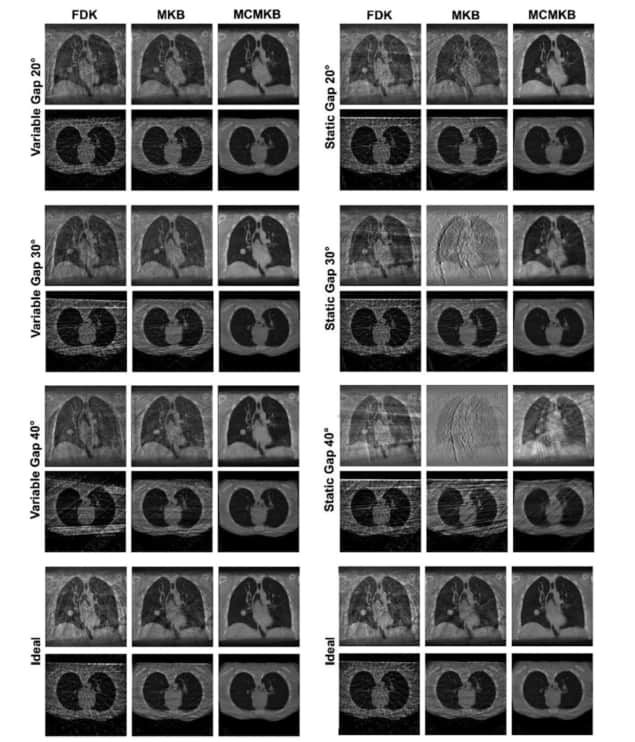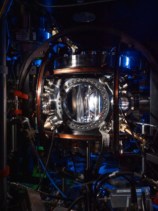
Four-dimensional cone-beam computed tomography (4D-CBCT) is an imaging technique employed during radiotherapy to help ensure the safe and accurate delivery of therapeutic radiation. Using the on-board kilovoltage imager found on most linear accelerator (linac) gantries, 4D-CBCT acquires X-ray projections and then groups the images into respiratory phase bins (usually 10 phases) to create a respiratory-correlated CBCT image. In this way, 4D-CBCT can capture breathing patterns and track the movement of the targeted tumour and nearby organs.
The use of 4D-CBCT for image guidance of lung cancer radiotherapy is increasing. However, clinical adoption is limited by inconsistent image quality, streaking artefacts and high imaging dose, as well as long scan times. The introduction of new linacs that can acquire 4D-CBCT scans in as little as 9.2 s, (compared with around 240 s for earlier models) could help. But it’s important to assess whether such fast gantry rotations can achieve suitable projection spacing across all of the required respiratory phases.
With this aim, researchers at the University of Sydney’s Image X Institute have analysed the impact of gantry velocity and angular separation between X-ray projections on 4D-CBCT image quality. They investigated whether constant and adaptive gantry velocity acquisitions are viable with advanced linacs and state-of-the-art reconstruction methods. Their findings, reported in Medical Physics, provide a guide for the future development of 4D-CBCT acquisition protocols on the newest generation of linacs.
Simulation studies
PhD student Benjamin Lau and his supervisor team used a 4D extended cardiac-torso (XCAT) digital phantom to simulate fast 4D-CBCT acquisitions (200 projections in 60–80 s). The XCAT contains a spherical tumour in the lung and was programmed with a sinusoidal breathing trace. The breathing trace was separated into 10 respiratory phases, and an XCAT volume generated for each.
The researchers first simulated patient scans on a constant velocity gantry system (the current clinical standard) using respiratory phase data from 30 patients participating in the ADAPT (adaptive CT acquisition for personalized thoracic imaging) clinical trial. To study the effects of rotation speed on image quality, they simulated four acquisition times (9.2, 60, 120 and 240 s), encompassing both the fastest possible gantry rotation speed (200° rotation in 9.2 s on the Varian Halcyon) and the current standard (200° in 240 s).
After simulating the projections, the team performed image reconstruction using three algorithms: Feldkamp–Davis-Kress (FDK), McKinnon-Bates (MKB), and motion compensated McKinnon Bates (MCMKB).
Simulations showed that reconstructions from constant gantry velocity acquisitions were streakier and contained more motion blur than ideal reconstructions with even angular spacing. The fastest acquisitions (9.2 and 60 s) with FDK or MKB reconstruction suffered the greatest reduction in image quality. MCMKB reconstruction reduced some streaks, noise and blur. Faster MCMKB acquisitions, however, still exhibited motion blur around the diaphragm and tumour, while slower acquisitions reduced blur but increased streak artefacts.
The researchers attribute these effects to inconsistent sampling of projections across each individual respiratory phase. In general, all constant gantry velocity reconstructions produced lower image quality than seen with ideal angular separation, for all acquisition times and reconstruction techniques.
To understand the impact of angular separation on image quality, the researchers simulated a series of acquisitions using variable angular gaps (in which fast or rapidly changing irregular breathing causes the gantry to miss a respiratory bin) and static angular gaps (where patient breath-holds result in missed data acquisition over a particular angular range) of 20°, 30° and 40°.
Static angular gaps had the greatest impact on image quality, with streak and noise artefacts increasing with greater gap size. Variable angular gaps, on the other hand, resulted in visually similar images to the ideal reconstructions, with MCMKB reconstructions having the least streaks and noise.
Adaptive acquisitions
The team also analysed the impact of adaptive gantry rotations – in which the gantry rotation speed is adapted to the patient’s breathing – using the angular position of X-ray projections from breathing traces of patients in the ADAPT trial. In general, projection angles from ADAPT patients produced image quality metrics similar to those from the ideal angular separation for all reconstructions.
Lau and colleagues note that this study is the first to investigate the impact of angular separation between projections on adaptive acquisition. “It is challenging to predict whether adaptive acquisition in clinical practice can achieve precise gantry control and its impact on image quality,” they write. Their analysis showed that image quality starts to degrade with an angular gap of 20° or larger, but that motion compensated reconstruction using the MCMKB algorithm could compensate for small to moderate deviations in angular separation.

On-board cone-beam CT visualizes delivered dose
Based on their findings, the researchers advise that acquiring fast low-dose 4D-CBCT acquisitions using a constant velocity gantry is not a feasible way to produce reconstructions that are similar to the ideal. However, they point out that precise angular spacing during fast low-dose adaptive 4D-CBCT may not be necessary to achieve high image quality. “The results demonstrate adaptive velocity gantry systems in conjunction with motion-compensated reconstruction may be a good option for fast low-dose 4D-CBCT to make full use of the emerging generation of faster rotating linear accelerators,” they write.
“With the emergence of fast gantry rotation systems, very fast 4D-CBCT scans can be acquired provided that the entire scan range is adaptively sampled, and motion-compensated reconstruction is performed in the context of patient positioning in radiotherapy,” the researchers conclude.
- SEO Powered Content & PR Distribution. Get Amplified Today.
- PlatoData.Network Vertical Generative Ai. Empower Yourself. Access Here.
- PlatoAiStream. Web3 Intelligence. Knowledge Amplified. Access Here.
- PlatoESG. Automotive / EVs, Carbon, CleanTech, Energy, Environment, Solar, Waste Management. Access Here.
- PlatoHealth. Biotech and Clinical Trials Intelligence. Access Here.
- ChartPrime. Elevate your Trading Game with ChartPrime. Access Here.
- BlockOffsets. Modernizing Environmental Offset Ownership. Access Here.
- Source: https://physicsworld.com/a/can-state-of-the-art-linacs-boost-the-uptake-of-4d-cbct-in-radiotherapy/
- :is
- :not
- :where
- 10
- 121
- 200
- 30
- 60
- 9
- a
- accelerator
- accelerators
- accurate
- Achieve
- acquire
- acquired
- Acquires
- acquiring
- acquisition
- acquisitions
- across
- adapt
- Adoption
- advanced
- advise
- aim
- algorithm
- algorithms
- All
- also
- an
- analysis
- and
- Angular
- ARE
- around
- AS
- assess
- At
- BE
- Benjamin
- between
- BIN
- blur
- boost
- both
- breathing
- but
- by
- CAN
- Cancer
- capture
- causes
- challenging
- changing
- click
- Clinical
- colleagues
- compared
- compensated
- conclude
- conjunction
- constant
- contained
- contains
- context
- control
- could
- create
- Current
- data
- delivered
- delivery
- demonstrate
- Development
- digital
- during
- each
- Earlier
- effects
- emergence
- emerging
- employed
- encompassing
- ensure
- Entire
- Even
- FAST
- faster
- fastest
- feasible
- findings
- First
- For
- found
- four
- from
- full
- future
- gap
- gaps
- General
- generated
- generation
- good
- greater
- greatest
- Group’s
- guidance
- guide
- had
- hand
- Have
- having
- help
- High
- his
- However
- HTTPS
- ideal
- image
- images
- Imaging
- Impact
- important
- in
- increased
- increasing
- individual
- information
- into
- Introduction
- investigate
- issue
- ITS
- jpg
- larger
- Lau
- least
- Limited
- little
- Long
- lower
- make
- max-width
- May..
- methods
- Metrics
- missed
- models
- more
- most
- motion
- movement
- necessary
- New
- Newest
- Noise
- of
- on
- open
- Option
- or
- Other
- out
- over
- participating
- particular
- patient
- patients
- patterns
- performed
- Personalized
- phantom
- phase
- Physics
- Physics World
- plato
- Plato Data Intelligence
- PlatoData
- Point
- position
- positioning
- possible
- practice
- precise
- predict
- produce
- Produced
- programmed
- Projection
- projections
- protocols
- provide
- provided
- quality
- Radiotherapy
- range
- rapidly
- Reduced
- reduction
- Reported
- required
- researchers
- result
- Results
- s
- safe
- scan
- seen
- Series
- showed
- similar
- Size
- small
- some
- speed
- standard
- starts
- state-of-the-art
- Still
- streak
- Student
- Study
- such
- suffered
- suitable
- sydney
- system
- Systems
- targeted
- team
- techniques
- than
- that
- The
- The Future
- their
- then
- These
- they
- this
- those
- three
- thumbnail
- times
- to
- Trace
- track
- trial
- true
- understand
- university
- use
- used
- using
- usually
- variable
- various
- VeloCity
- very
- viable
- volume
- was
- Way..
- WELL
- were
- whether
- which
- while
- with
- world
- write
- X
- x-ray
- zephyrnet













